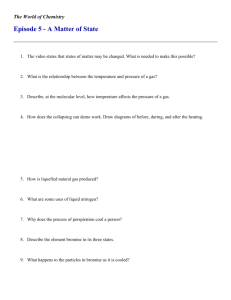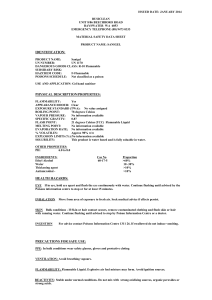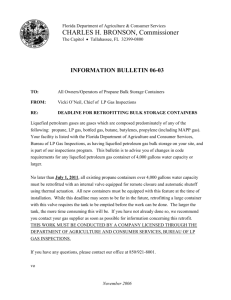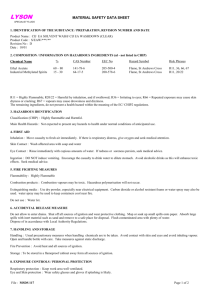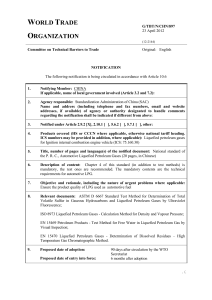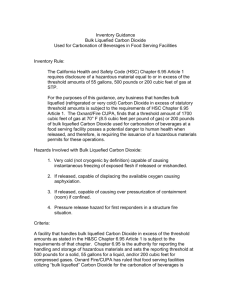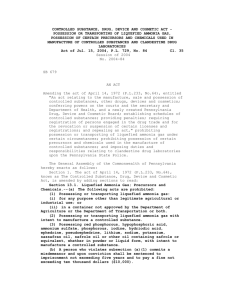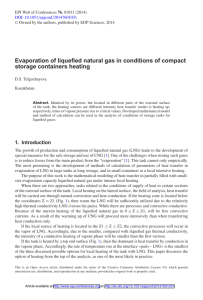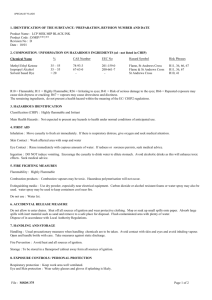SAFETY DATA SHEET LIQUEFIED NATURAL GAS
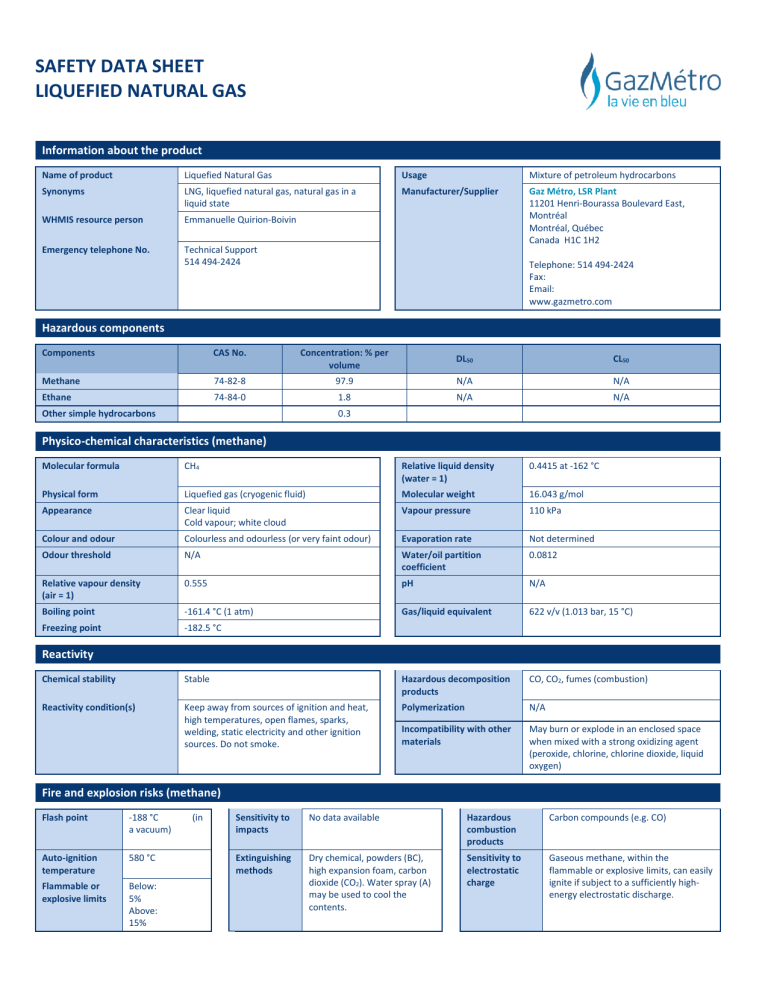
SAFETY DATA SHEET
LIQUEFIED NATURAL GAS
Information about the product
Name of product
Synonyms
WHMIS resource person
Liquefied Natural Gas
LNG, liquefied natural gas, natural gas in a liquid state
Emmanuelle Quirion-Boivin
Emergency telephone No. Technical Support
514 494-2424
Usage
Manufacturer/Supplier
Mixture of petroleum hydrocarbons
Gaz Métro, LSR Plant
11201 Henri-Bourassa Boulevard East,
Montréal
Montréal, Québec
Canada H1C 1H2
Telephone: 514 494-2424
Fax:
Email: www.gazmetro.com
Hazardous components
Components
Methane
Ethane
Other simple hydrocarbons
74-82-8
74-84-0
Physico-chemical characteristics (methane)
Molecular formula CH
4
Physical form
Appearance
Colour and odour
Odour threshold
Relative vapour density
(air = 1)
Boiling point
Freezing point
Reactivity
Chemical stability
-161.4 °C (1 atm)
-182.5 °C
Stable
CAS No. Concentration: % per volume
97.9
1.8
0.3
DL
50
N/A
N/A
Liquefied gas (cryogenic fluid)
Clear liquid
Cold vapour; white cloud
Colourless and odourless (or very faint odour)
N/A
0.555
Relative liquid density
(water = 1)
Molecular weight
Vapour pressure
Evaporation rate
Water/oil partition coefficient pH
Gas/liquid equivalent
Reactivity condition(s) Keep away from sources of ignition and heat, high temperatures, open flames, sparks, welding, static electricity and other ignition sources. Do not smoke.
Hazardous decomposition products
Polymerization
Incompatibility with other materials
0.4415 at -162 °C
16.043 g/mol
110 kPa
Not determined
0.0812
N/A
CL
50
N/A
N/A
622 v/v (1.013 bar, 15 °C)
CO, CO
2
, fumes (combustion)
Fire and explosion risks (methane)
Flash point
Auto-ignition temperature
Flammable or explosive limits
-188 °C (in a vacuum)
580 °C
Below:
5%
Above:
15%
Sensitivity to impacts
No data available
Extinguishing methods
Dry chemical, powders (BC), high expansion foam, carbon dioxide (CO
2
). Water spray (A) may be used to cool the contents.
Hazardous combustion products
Sensitivity to electrostatic charge
N/A
May burn or explode in an enclosed space when mixed with a strong oxidizing agent
(peroxide, chlorine, chlorine dioxide, liquid oxygen)
Carbon compounds (e.g. CO)
Gaseous methane, within the flammable or explosive limits, can easily ignite if subject to a sufficiently highenergy electrostatic discharge.
Fire and explosion risks (cont.)
Special techniques
Explosibility conditions
Do not try to extinguish the fire if the gas leak cannot be stopped. Intervene at a distance, approaching downwind, if necessary. If needed, use a combustible gas detector (explosimeter). Establish a security perimeter.
In case of fire, and if it can be done safely, close the gas inlet valve.
The vapours generated during a significant spill of liquefied gas may travel a long way to a distant ignition source and produce a flashback.
The spilled liquid may pool on the ground and flow toward lower points until the cloud temperature rises to more than -100 C.
Do not use carbon dioxide, low-expansion foam or a strong water spray directly on the liquefied gas.
Using water or any other liquid at room temperature directly on the liquefied gas will instantaneously vaporize the gas.
Wear a supplied-air respirator near the leak to avoid any risk of asphyxiation.
Cool the exposed containers with water spray. Help the gas cloud to disperse using a water spray.
The vapours may form a flammable mixture with air, which, in case of ignition, may release an explosive force if in an enclosed space .
Risk of RPT (Rapid Phase Transition): the significant difference in temperature between the LNG and a hotter liquid may cause the "almost instantaneous" vaporization of the LNG. The sudden increase in total volume occupied by the LNG may generate a
"cold explosion" shock wave (sudden generation of overpressure but without combustion).
Toxicological properties
WHMIS Classification: B1
Flammable gas
Absorption or exposure points Respiratory tracts and skin. Physiologically inert. Ingestion unlikely during normal industrial use.
Contact with the skin and eyes Tissue damage caused by frostbite on contact with liquefied gas. The vapours are not irritants. However, direct contact of the eyes, skin or mucous membranes with the cold vapours or liquid gas may cause frostbite, burns and permanent ocular and skin lesions.
The signs of frostbite are a change in the colour of the skin to grey or white, followed later by blisters.
The skin may become inflamed and painful.
Acute exposure/Exposure to vapours
The vapours have a narcotic effect. Because of the very rapid rate of evaporation, all the air may be displaced, leading to a risk of asphyxiation.
Methane is a simple asphyxiant. Exposure to very high concentrations of methane may induce asphyxiation since it displaces the oxygen in the air.
The principal symptoms associated with asphyxiation are rapid pulse and respiration, headaches, dizziness, visual problems, mental confusion, impaired coordination, mood changes, muscular weakness, trembling, cyanosis, narcosis, numbness of the extremities, unconsciousness leading to a lesion in the central nervous system that may result in death by anoxia.
The effects of asphyxiation may be felt more rapidly during physical effort since oxygen consumption is increased.
Even though considered non-toxic by inhalation, exposure to high concentrations of LNG may cause a depression of the nervous system (rapid respiration, dizziness, somnolence, headaches—symptoms similar to those of drug use), but without any long-term effects.
People with pre-existing heart, lung and/or blood conditions may have an increased sensitivity to symptoms of asphyxiation.
Chronic exposure
Toxicity
No data
Simple asphyxiant
SIMPLE ASPHYXIANT : A physiologically inert gas that exerts its action by displacing the oxygen in the air and that may thus lower the percentage volume of oxygen below the 19.5% needed to maintain oxygen saturation.
Irritant and corrosive properties
Sensitivity to the product
Possibility of frostbite on contact with liquefied gas.
No data concerning respiratory or skin sensitivity were found in the documentary sources consulted.
Carcinogenicity No data concerning a carcinogenetic effect were found in the documentary sources consulted (OSHA, ACGIH).
Toxic effects on reproduction No data concerning effects on reproduction were found in the documentary sources consulted.
Teratogenicity
Mutagenicity
No data concerning a teratogenic effect were found in the documentary sources consulted.
No data concerning a mutagenic effect whether in vivo or in vitro on mammalian cells were found in the documentary sources consulted.
No data available Toxicologically synergic products
Preventive measures
Eyes
Skin
Inhalation
Wear eye protection if there is a risk of refrigerated liquefied gas splatters. The choice of eye protection, goggles, face shields, etc., depends on the nature of the work to be done and the risk of exposure.
In case of a risk of contact with refrigerated liquefied gas, wear a face shield and waterproof low-temperature-resistant clothing
(apron, cryogenic gloves). Flame-retardant clothing may also be worn, depending on the nature of the work and the risk of fire.
In general, no protection is necessary if there is sufficient oxygen. Wear a supplied-air respirator if the concentration in the work area is likely to induce asphyxiation.
Keep away from flames, sparks and excessive temperatures.
Never respond alone to a significant incident.
Specific technical mechanisms to be used
Handling methods and equipment
Measures to be taken in case of a leak or spill
Elimination of residues
Storage
Shipping and transporting
Use only in well-ventilated areas. See also OSHA regulations regarding the handling of this product, including standard
29 CFR 1910.110: Storage and handling of liquefied petroleum gases.
Activate the Emergency Measures Plan in case of a spill.
Evacuate non-essential personnel and establish a security perimeter.
Suppress or control all ignition sources.
Check the condition and characteristics of the container.
Consider the meteorological conditions (wind speed and direction, temperature, humidity).
Stay upwind and, if possible, evaluate the direction taken by the product.
The vapour cloud may be white, but the colour dissipates and there is always the risk of a fire or an explosion.
Do not flush, or allow the LNG to flow, down the drain or into the sewer system. Check if combustible gas is present in the sewers, underground structures and buildings.
Do not touch the spilled liquid.
Use water spray to disperse vapours.
Isolate the area until the gas has dispersed.
Aerate and test the area before entering.
Let the gas escape into the atmosphere.
In the event of significant quantities, consult the regional office of the environmental authority that has jurisdiction.
Store only in containers approved for liquid natural gas. See also OSHA regulations regarding the handling of this product, including standard 29 CFR 1910.110: Storage and handling of liquefied petroleum gases.
UN number: UN1972
NATURAL GAS, REFRIGERATED LIQUID with high methane content
Classification: 2.1
Flammable gas
First aid
Contact with the eyes
Contact with the skin
Inhalation
In case of frostbite or freezing, gently rise the eyes with warm water. DO NOT RINSE THE EYES WITH HOT WATER.
Keep the eyelids open wide to allow the liquid to evaporate.
If the person cannot tolerate the light, protect the eyes with a bandage or handkerchief.
Do not put any ointment in the eyes without medical advice.
Consult a doctor immediately.
Remove contaminated clothing and rinse the affected area with warm water.
The exposed area may be warmed, but DO NOT USE HOT WATER.
Consult a doctor immediately in the event of frostbite or blisters.
Move the exposed person to fresh air.
If the person is not breathing, call 911 or an ambulance, then administer CPR.
If breathing is difficult, give oxygen.
Never try to make an unconscious person drink. Do not leave victims unattended.
Consult a doctor immediately.
Information about the preparation of the Safety Data Sheet
Additional information and comments: the natural gas Safety Data Sheet is available on Gaz Metro's website at www.gazmetro.com in the About us section, under the Natural Gas tab.
Prepared by: the Health and Safety department Telephone No.: 514 598-3270 Prepared on: July 27, 2015
